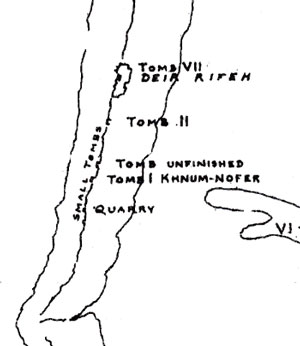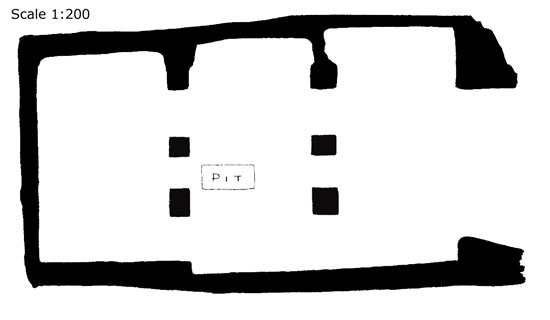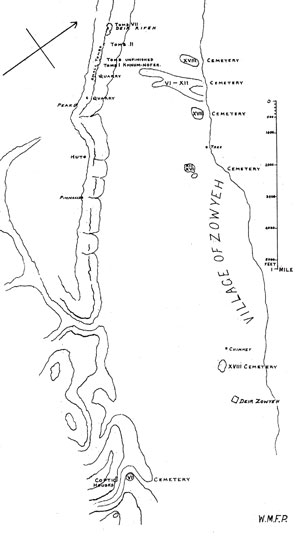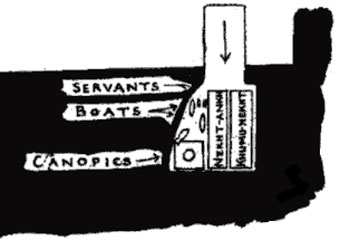|
|

|
|
Engraved inscription are on the north wall; on the west are the colossal figures of the man and his son, also a false door painted and traces of a scene of the deceased seated with inscription above it. On the south are traces of ships, and short phrases. The west side of the chamber is 389" by 458". The south-east corner is entirely cut away, owing to Roman quarrying. Also the whole floor has been lowered from about three to ten feet by quarrying.
|

|
 Tomb No.2, of Khnum-Aa containing the burials of Khnum-Nakht and Nekht-Ankh The most important tomb is a large un-sculptured tomb of three chambers, with three burial pits. It's style indicates the 12th dynasty, but the only written information is an ink-written inscription of a re-use during Rameses III's reign (20th Dynasty). The courtyard is 215" by 400"; the passage 101" by 171"; the hall 292" x 283" x 474" x 470". The back chamber 204" x 203" x 208" x 210", the recess 46" x 62"; the side chamber 130" x 103" x 102", the recess 39" wide. In this area a number of small tombs were found, plundered in antiquity. The tomb of Nekht-Ankh,
son of Aa-Khnumu, was the found un-plundered. A descending slope led to a small chamber barely large enough to hold the
funeral furniture, 80" by 70" at the south-east back and only 50" in front. The heads of the coffins were toward the
opening of the tomb. The finest coffin, Nekht-Ankh, was that next to the canopic box. It contained, lying on its side, the
finely decorated body coffin of ha-prince Nekht-Ankh.
|
12th Dynasty tomb equipment At
the beginning of the 12th Dynasty the elite/royal cemetery moved from Thebes to Lisht, which has a different kind of topography.
The area didn't have adjacent cliffs and mastaba type tombs replaced rock tombs. However, in the area that the brothers
were buried, the local tradition of rock cut tombs continued in the Middle Kingdom and it into the New Kingdom (Petrie excavated
tombs dating until the 18th Dynasty at Rifeh). Rock-cut tombs are generally well preserved but are not typical of the period. At
the beginning of the 12th Dynasty the elite/royal cemetery moved from Thebes to Lisht, which has a different kind of topography.
The area didn't have adjacent cliffs and mastaba type tombs replaced rock tombs. However, in the area that the brothers
were buried, the local tradition of rock cut tombs continued in the Middle Kingdom and it into the New Kingdom (Petrie excavated
tombs dating until the 18th Dynasty at Rifeh). Rock-cut tombs are generally well preserved but are not typical of the period.
Written text has always been an important part of Egyptian burials. Canopic jars underwent changes in their form during the Middle Kingdom. At the beginning of the period jars with human heads are found. The jar stoppers are made of wood and the body of the jar is often made of clay; high quality examples may be made from limestone or calcite. A set of canopic jars (within a chest) is normal within an elite burial, but less common in the provinces. Many refinements found in the elite cemeteries were later introduced in the provincial cemeteries. For example, coffins with a palace facade were found at a Lisht early in the period and only appeared later in the Middle Kingdom in provincial cemeteries - the same can be said of wooden models of solar boats. The reign of Senusret III (ruled 1870-1831 BC), introduce change into all areas of life in Ancient Egypt. It seems that major reorganisation of the administration happened during this time, new titles appeared in the administration and some provincial cemeteries cease to exist, and other cemeteries continued but on a much smaller scale. The body of the dead person was now no longer placed on its left side, but laid on its back with its hands by its side. The disappearance of Coffin Texts and Wooden models is noticeable. Only a limited set of objects were specifically manufactured for burial, for example heart scarabs and mummiform figures. During the 13th Dynasty the palace facade disappeared from coffins. In Upper Egypt the number of columns was increased, some coffins at eight or nine columns on each long sight. In lower Egypt coffins with four columns of text on the alongside and religious texts in the space between are found. It is clear that significant change to burial customs did not happen between Dynasties which makes it very difficult to date a burial, for example, the 12th or 13th Dynasty. It is even more difficult to determine where, within a Dynasty, where a burial can be placed. From the quality of Nekht-Ankh's burial, the canopic jars, model boats, style of coffin and columns
of text and the similar style of Khnum-Nakht's coffin, we could propose that they lived within the early part of the 12th
Dynasty, possible before Senusret III's reign. |
| Main page of the The Two Brothers Khnum-Nakht and Nekht-Ankh. |
|
|



 The second coffin and body coffin
are inferior, and are for Khnum-Nakht.
The second coffin and body coffin
are inferior, and are for Khnum-Nakht.